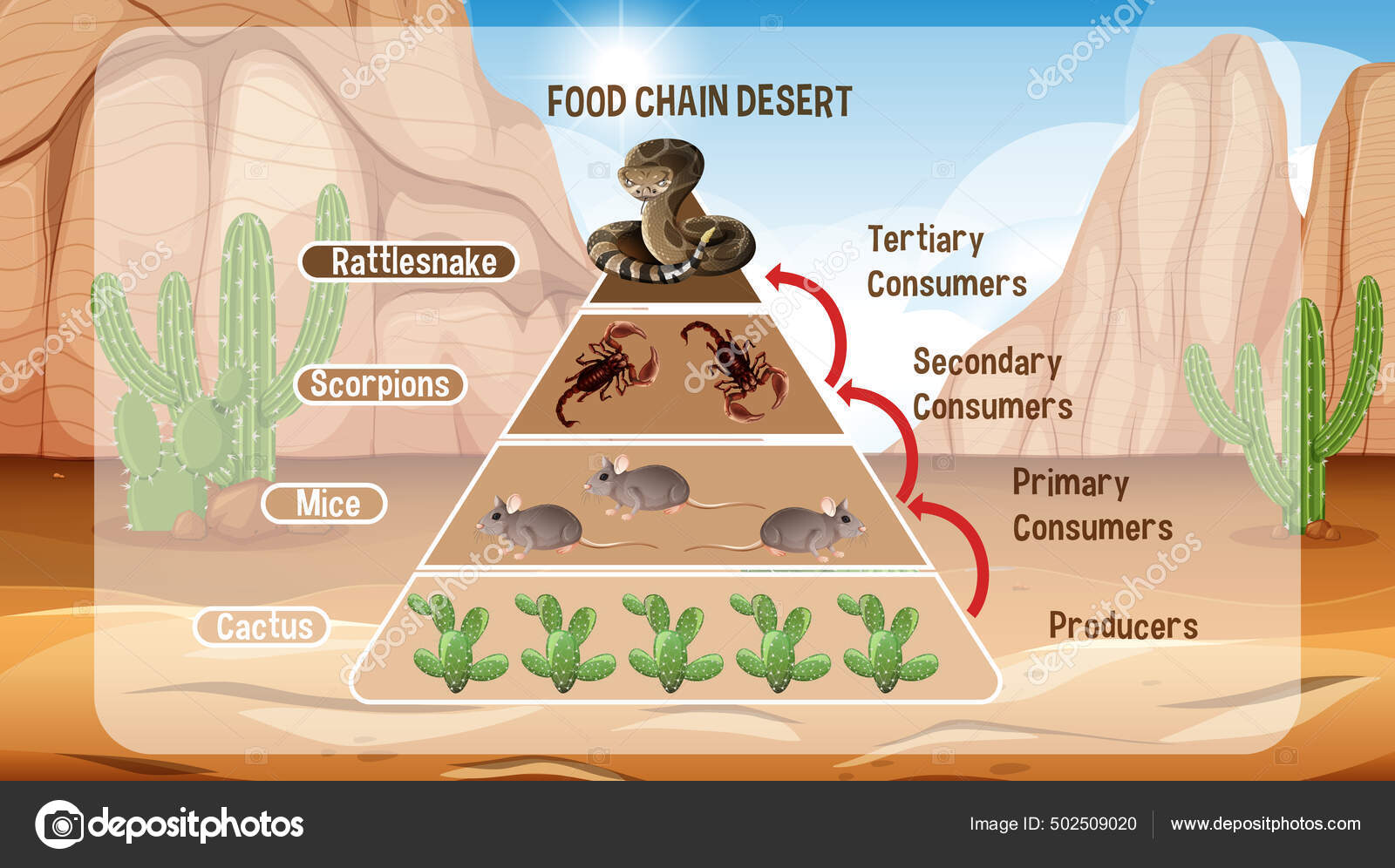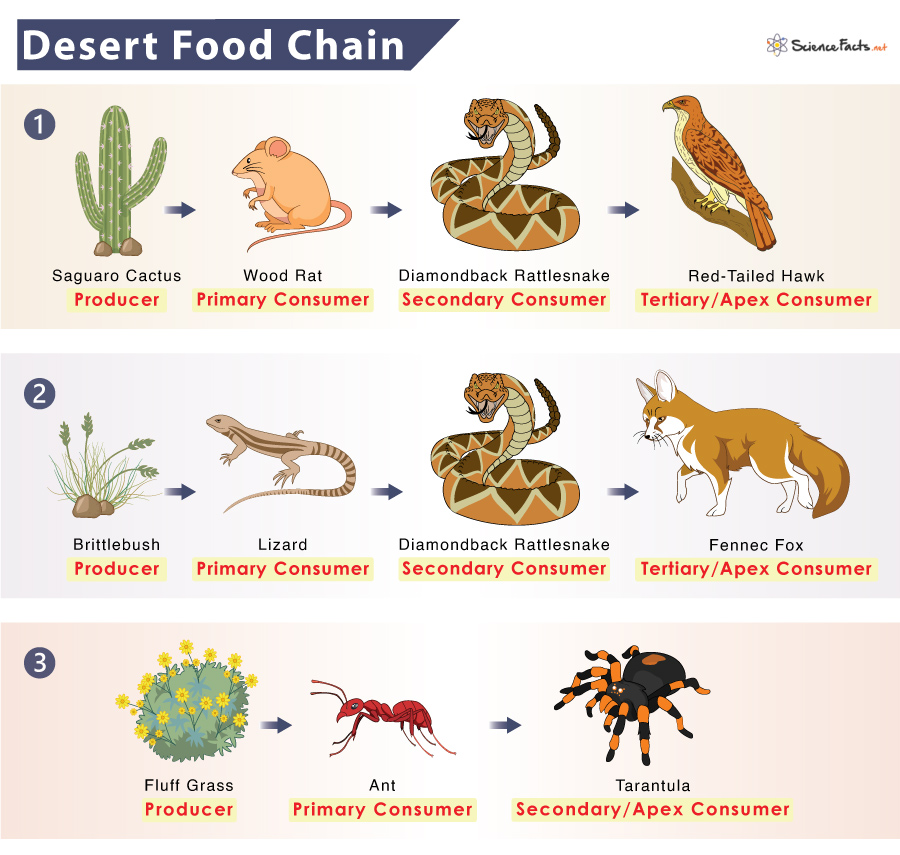Within the middle of arid areas lies a fascinating ecosystem the place lifestyles adapts and prospers in bizarre tactics. Delving into the meals chain for wasteland, we discover an enchanting internet of interdependence and resilience that sustains this distinctive surroundings.
From the smallest bugs to the majestic predators, every organism performs a a very powerful position in keeping up the sophisticated stability of the wasteland ecosystem.
Barren region Meals Chain Construction
The wasteland meals chain, not like different ecosystems, reveals a singular construction because of the shortage of water and restricted crops. It accommodates quite a lot of trophic ranges, every taking part in a a very powerful position in keeping up the sophisticated stability of the wasteland ecosystem.
Manufacturers
The basis of the wasteland meals chain lies with the manufacturers, basically vegetation and sure microorganisms. Those organisms harness daylight via photosynthesis, changing it into energy-rich compounds that function the principle supply of sustenance for all different organisms within the wasteland ecosystem.
Number one Shoppers
Number one shoppers are herbivores that feed at once at the manufacturers. Those come with bugs, rodents, and reptiles. Through eating vegetation, they download the important vitamins to maintain themselves and supply an important hyperlink between manufacturers and better trophic ranges.
Secondary Shoppers
Secondary shoppers are carnivores that prey on number one shoppers. Examples come with snakes, birds, and small mammals. They play a a very powerful position in regulating the populations of herbivores, combating overgrazing and keeping up the stability of the wasteland ecosystem.
Tertiary Shoppers
Tertiary shoppers are apex predators that occupy the easiest trophic degree. Those come with huge carnivores corresponding to coyotes, wolves, and eagles. They play a essential position in controlling the populations of secondary shoppers and making sure the stableness of the wasteland ecosystem.
Decomposers
Decomposers, corresponding to micro organism and fungi, are crucial for nutrient biking within the wasteland ecosystem. They spoil down useless organisms and natural topic, liberating crucial vitamins again into the soil, which will then be used by manufacturers.
Variations for Survival

Within the harsh wasteland surroundings, vegetation and animals have advanced outstanding variations to live to tell the tale the intense stipulations. Those variations allow them to procure meals and water in a panorama the place sources are scarce.
Plant Variations, Meals chain for wasteland
- Succulence:Barren region vegetation retailer water of their fleshy stems and leaves, permitting them to resist lengthy classes of drought.
- Deep Root Methods:Vegetation increase intensive root methods that extend deep into the bottom, gaining access to water assets unavailable to shallow-rooted species.
- Thick Cuticles:Leaves and stems are lined with a thick cuticle that reduces water loss via evaporation.
- CAM Photosynthesis:Some wasteland vegetation use CAM (Crassulacean Acid Metabolism) photosynthesis, which minimizes water loss through opening their stomata at night time to take in carbon dioxide.
Animal Variations
- Nocturnal Job:Many wasteland animals are nocturnal, heading off the serious warmth and water loss all over the day.
- Water Conservation:Animals have environment friendly kidneys and bring concentrated urine to reduce water loss.
- Behavioral Variations:Animals search safe haven underneath rocks or in burrows to flee the solar and preserve water.
- Environment friendly Foraging:Barren region animals have specialised diets and feeding methods to maximise meals consumption whilst minimizing calories expenditure.
Power Waft and Nutrient Biking
The wasteland meals chain, like any ecosystems, depends on the switch of calories and biking of vitamins to maintain its subtle stability. Working out this waft and biking is a very powerful for comprehending the wasteland’s ecological dynamics.
Power, to start with captured through manufacturers via photosynthesis, flows throughout the meals chain as organisms devour every different. Number one shoppers, corresponding to herbivores, download calories through feeding on manufacturers. Secondary shoppers, like carnivores, devour number one shoppers, and so forth. With every switch, calories is misplaced as warmth, leading to a gentle lower in calories availability at upper trophic ranges.
Nutrient Biking
Nutrient biking comes to the transformation and motion of crucial components inside the ecosystem. Manufacturers take in vitamins from the soil and surroundings, which might be then handed up the meals chain via intake. Decomposers, corresponding to micro organism and fungi, spoil down useless organisms and natural topic, liberating vitamins again into the soil.
This procedure guarantees a continual provide of vitamins for plant expansion and number one manufacturing.
Components Affecting Power and Nutrient Availability
- Local weather:Temperature and precipitation patterns affect plant expansion and nutrient availability. Excessive warmth and drought can cut back plant productiveness, impacting calories waft and nutrient biking.
- Soil Prerequisites:Soil high quality impacts nutrient availability for vegetation. Nutrient-poor soils prohibit plant expansion, lowering calories waft and nutrient biking.
- Human Actions:Land use adjustments, grazing, and air pollution can disrupt nutrient biking and effort waft, affecting the stableness of wasteland ecosystems.
Interdependence and Symbiosis
The wasteland meals chain is a fancy internet of interactions between organisms, the place interdependence and symbiosis play a very powerful roles in keeping up the stableness and resilience of the ecosystem.
Symbiotic relationships within the wasteland meals chain can also be categorised into 3 major varieties: mutualism, commensalism, and parasitism.
Mutualism
- Barren region vegetation and pollinators:Barren region vegetation depend on pollinators, corresponding to bugs and birds, to switch pollen between flora, enabling replica. In go back, pollinators get pleasure from the nectar and pollen equipped through the vegetation as a meals supply.
- Ants and acacia timber:Ants construct nests within the hole thorns of acacia timber, protective them from herbivores. The ants additionally feed at the nectar produced through the timber, whilst the timber get pleasure from the ants’ coverage.
Commensalism
- Mistletoe and wasteland timber:Mistletoe vegetation develop at the branches of wasteland timber, the use of them as strengthen. The mistletoe does no longer hurt the timber, but it surely advantages from the daylight and vitamins to be had within the tree’s cover.
- Rodents and burrow-dwelling animals:Rodents dig burrows within the wasteland, which give safe haven for different animals, corresponding to lizards and snakes. The rodents don’t get pleasure from the presence of those animals, however the latter get pleasure from the safe haven equipped through the burrows.
Parasitism
- Fleas and wasteland animals:Fleas are exterior parasites that feed at the blood of wasteland animals. The animals be afflicted by the lack of blood and will grow to be weakened or diseased, whilst the fleas get pleasure from the vitamins got from their hosts.
- Tapeworms and wasteland predators:Tapeworms are interior parasites that are living within the digestive tracts of wasteland predators. They take in vitamins from the predators’ meals, inflicting malnutrition and well being issues within the host animals.
Disturbances and Resilience

Barren region meals chains, like any ecosystems, face quite a lot of disturbances that may modify their construction and dynamics. Working out those disturbances and the resilience mechanisms that allow the wasteland meals chain to recuperate is a very powerful for its conservation and control.
Kinds of Disturbances
- Local weather variability and extremes:Deserts revel in excessive temperature fluctuations, droughts, and floods, which will affect plant and animal survival.
- Human actions:Land use adjustments, habitat fragmentation, and air pollution can disrupt meals chains through changing habitat availability and useful resource abundance.
- Invasive species:Non-native species can compete with local species for sources, resulting in inhabitants declines and ecosystem disruption.
- Fireplace:Wildfires can burn crops, destroying habitat and meals assets for animals.
- Illness outbreaks:Pathogens can unfold abruptly via wasteland populations, inflicting vital mortality and disrupting meals chains.
Have an effect on on Ecosystem Construction and Dynamics
Disturbances can affect wasteland meals chains in numerous tactics:
- Altered species composition:Disturbances can prefer positive species over others, resulting in adjustments in neighborhood construction.
- Diminished biodiversity:Excessive disturbances may end up in species extinctions and a decline in general biodiversity.
- Disrupted calories waft:Disturbances can disrupt calories switch between trophic ranges, affecting the supply of meals sources.
- Altered nutrient biking:Disturbances can have an effect on nutrient availability and biking processes, impacting plant expansion and animal well being.
Resilience Mechanisms
Regardless of those disturbances, wasteland meals chains showcase resilience, enabling them to recuperate and care for ecosystem serve as. Key resilience mechanisms come with:
- Variations to excessive stipulations:Barren region species have advanced physiological and behavioral variations that permit them to live to tell the tale in harsh stipulations.
- Seed banks and dormancy:Many wasteland vegetation produce dormant seeds that may stay viable for prolonged classes, permitting them to recolonize after disturbances.
- Dispersal and colonization:Barren region animals and vegetation have tailored to disperse lengthy distances, facilitating recolonization of disturbed spaces.
- Mutualistic relationships:Symbiotic relationships between species, corresponding to pollination and seed dispersal, give a boost to ecosystem steadiness and resilience.
- Ecological reminiscence:Barren region ecosystems have a “reminiscence” of previous disturbances, which influences their reaction to long term occasions.
Human Affects: Meals Chain For Barren region

Human actions have a vital affect on wasteland meals chains. Those affects can also be direct, corresponding to habitat loss and air pollution, or oblique, corresponding to local weather exchange.
Habitat lossis likely one of the most important threats to abandon meals chains. As human populations develop, so does the call for for land for building. This building can result in the destruction of wasteland habitats, which will in flip result in the lack of meals assets for wasteland animals.
Air pollution
Air pollution is any other main risk to abandon meals chains. Pollution can input the wasteland surroundings via a lot of assets, together with commercial actions, agricultural runoff, and car emissions. Those pollution can hurt wasteland animals at once, or they may be able to not directly hurt them through contaminating their meals assets.
Local weather Trade
Local weather exchange could also be a big risk to abandon meals chains. Because the local weather adjustments, the distribution of wasteland vegetation and animals is more likely to exchange. This would result in the lack of meals assets for some wasteland animals, and it might additionally make it tougher for them to search out friends.
Mitigating those affectsis very important for preserving wasteland ecosystems. There are a variety of items that may be carried out to mitigate the affects of human actions on wasteland meals chains, together with:
- Protective and restoring wasteland habitats
- Decreasing air pollution
- Addressing local weather exchange
Useful Solutions
What are the important thing variations that allow organisms to live to tell the tale in wasteland stipulations?
Organisms within the wasteland have advanced outstanding variations, corresponding to water garage mechanisms, specialised feeding behavior, and physiological variations to preserve water and effort.
How does the waft of calories throughout the wasteland meals chain affect nutrient availability?
The waft of calories throughout the meals chain determines the supply of vitamins, as manufacturers convert daylight into calories and shoppers make the most of those vitamins for expansion and replica.
